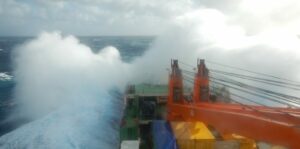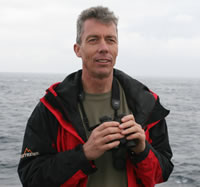By Peter Ryan, onboard scientist, expert in general ornithology, seabird-fishery interactions, evolutionary ecology, marine debris, solid waste management, biology of oceanic islands.
Leg 2, Day 2.
Today started innocuously enough with near calm seas and heavy rain as a frontal system passed over the ship. By mid-morning, however, the wind had increased, and after lunch was gusting at over 60 knots, turning the sea into a heaving mass of white water and confining us indoors. Birds were thin on the ground, and for the first day of the trip we failed to see a single albatross. The day list equaled the lowest total to date, with only 9 species of birds recorded:
| Short-tailed Shearwater | 80 | White-chinned Petrel | 7 |
| Mottled Petrel | 6 | Fairy Prion | 5 |
| White-headed Petrel | 4 | Giant petrel sp. | 1 |
| Little Shearwater | 1 | Gould’s Petrel | 1 |
| Black-bellied Storm Petrel | 1 |
People visiting the bridge asked how seabirds cope in these trying conditions. The simple answer is we are not really sure. When trapped against land, large numbers can die in so-called ‘wrecks’, but this might not relate to the immediate conditions. For example, in August 1984 many Blue and Kerguelen Petrels were wrecked along the South African coast during a winter storm, but observations at sea showed that they were present offshore at least three weeks prior to the storm. It seems they were already out of range, and possibly out of condition, when the storm struck. At the same time these species – rarely seen in temperate latitudes – were recorded in Australia, New Zealand and South America. Today, Short-tailed Shearwaters flew south into the teeth of wind, without apparent effort.
Conditions were marginal for observation. The only marine mammal seen was a fur seal playing in the wild seas in mid-afternoon, and only two Bull Kelps were seen. We hope for calmer seas tomorrow…

